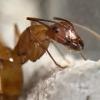Same. Same week they became available. Makes sense they died. Brood boosted queens were weak and didn’t have their own workers.
- Formiculture.com
- Forums
- Gallery
- Members
- Member Map
- Chat

Same. Same week they became available. Makes sense they died. Brood boosted queens were weak and didn’t have their own workers.
I have seen colonies simply crash and burn out for no apparent reason (one of them same species as one of my most successful colonies), and other people report it too. I also really wonder what's going on. Maybe a trace chemical exposure, maybe some kind of invisible parasite, maybe a messed up diapause in some cases ... I don't know.
BUT on the topic of Camponotus, whatever happened to the theory that many Camponotus, especially older/larger colonies, need uric acid or urea? (A good source being fresh bird poop whites, possibly, or ... other sources of it.)
Formiculture Journals::
Veromessor pergandei, andrei; Novomessor cockerelli
Camponotus fragilis; also separate journal: Camponotus sansabeanus (inactive), vicinus, laevigatus/quercicola
Liometopum occidentale; Prenolepis imparis; Myrmecocystus mexicanus (inactive)
Pogonomyrmex subnitidus and californicus (inactive)
Tetramorium sp.
Termites: Zootermopsis angusticollis
Isopods: A. gestroi, granulatum, kluugi, maculatum, vulgare; C. murina; P. hoffmannseggi, P. haasi, P. ornatus; V. parvus
Spoods: Phidippus sp.
0 members, 1 guests, 0 anonymous users